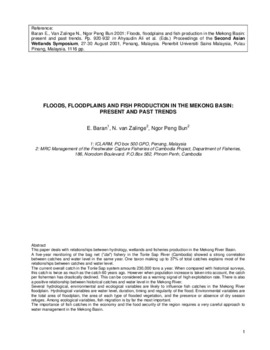Floods, floodplains and fish production in the Mekong basin: present and past trends

Citation
Baran, E.; Van Zalinge, N.; Ngor Peng Bun (2001). Floods, floodplains and fish production in the Mekong basin: present and past trends. p. 920-932. In Ahyaudi Ali et al. (eds) Proceedings of the second Asian wetlands symposium, 27-30 August 2001, Penang, Malaysia. Penerbit Universiti Sains Malaysia, Pulau Pinang, Malaysia. 1116 p.
This paper deals with relationships between hydrology, wetlands and fisheries production in the Mekong River Basin. A five-year monitoring of the bag net ("dai") fishery in the Tonle Sap River (Cambodia) showed a strong correlation between catches and water level in the same year. One taxon making up to 37% of total catches explains most of the relationships between catches and water level. The current overall catch in the Tonle Sap system amounts 230,000 tons a year. When compared with historical surveys, this catch is twice as much as the catch 60 years ago. However when population increase is taken into account, the catch per fisherman has drastically declined. This can be considered as a warning signal of high exploitation rate. There is also a positive relationship between historical catches and water level in the Mekong River. Several hydrological, environmental and ecological variables are likely to influence fish catches in the Mekong River floodplain. Hydrological variables are water level, duration, timing and regularity of the flood. Environmental variables are the total area of floodplain, the area of each type of flooded vegetation, and the presence or absence of dry season refuges. Among ecological variables, fish migration is by far the most important. The importance of fish catches in the economy and the food security of the region requires a very careful approach to water management in the Mekong Basin.
Permalink
Date Available
Publisher
Countries
Research Themes
Language